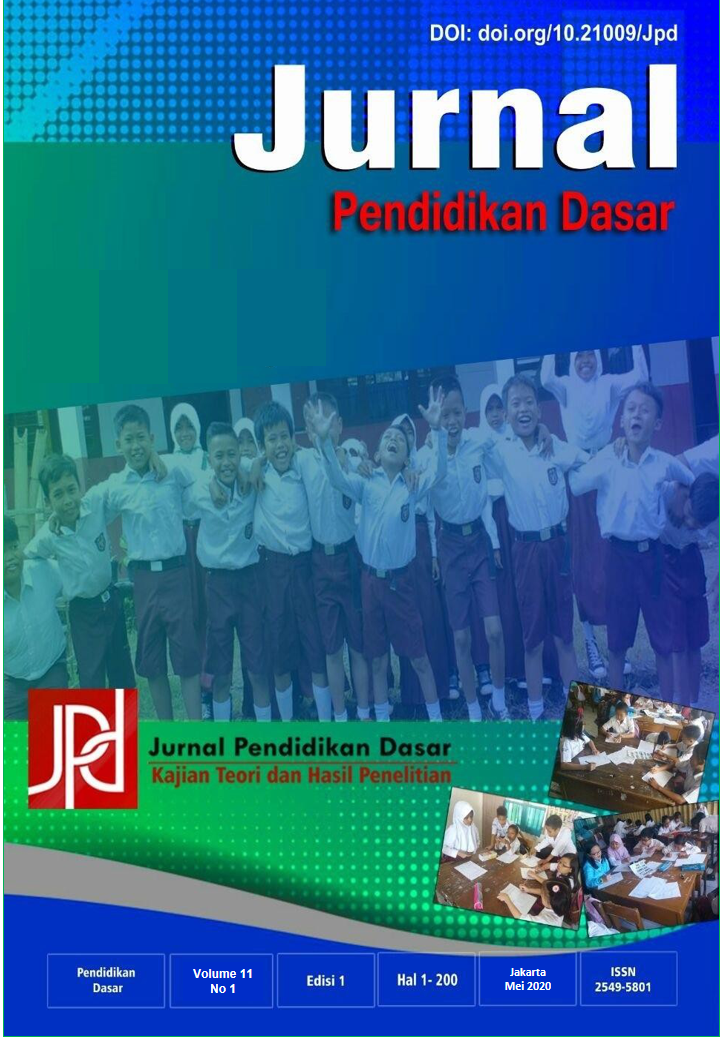ANALISIS KEMAMPUAN MENULIS KOSAKATA BAHASA INDONESIA SISWA KELAS III SEKOLAH DASAR
DOI:
https://doi.org/10.21009/jpd.v11i1.15295Keywords:
analisis, menulis, kosakata bahasa IndonesiaAbstract
Based on field observation since 1999 until now, children who use the Tamong language as the first language often make mistakes in expressing thoughts, both verbally and writing. These errors can be observed in the pronunciation and writing of Indonesian vocabulary since they are in primary education up to secondary education. This causes errors and doubts in the interpretation of the meaning of the word by the recipient of the message from another area. This study aims to describe the analysis of the ability to write Indonesian vocabulary for third grade students of 19 Rambai Primary School Bengkayang Regency. This study use descriptive qualitative method. Data collection techniques using documents and observation. The writer acts as an instrument for collecting data. Using data analysis techniques interactive analysis models through the stages of data reduction, data presentation, and drawing conclusions. The subjects of this study were all students of third grade 2018/2019 school year. The number of students are 33 people. The results show that the writing of third grade students in terms of the position and number of consonant letters in one word shows variations in change from c to s, s to c, r to l, and l to r. Based on the results of this research and discussion, it can be concluded that the ability to writing Indonesian language vocabulary for third grade students of 19 Rambai Primary School, Bengkayang Regency has showed a changed in the variations consonant letter due to the influence of Tamong regional language usage habits that do not recognize phonemes /c/ and /r/, also students lack of understanding of the spelling and the meaning of Indonesian vocabulary
References
Badan Pengembangan dan Pembinaan Bahasa Kementrian Pendidikan dan Kebudayaan. (2017). Kamus Besar Bahasa Indonesia. Jakarta: Balai Pustaka.
Chaer, A. (2011). Ragam Bahasa Indonesia. Jakarta: Rineka Cipta.
Djiwandono, S. (2011). Tes Bahasa: Pegangan bagi Pengajar Bahasa. Jakarta: Indeks.
Doyin, & Wagiran. (2009). Bahasa Indonesia Pengantar Penulisan Karya Ilmiah. Semarang: UNNES Press.
Hastuti, S. (2003). Sekitar Analisis Kesalahan Berbahasa Indonesia. Yogyakarta: Mitra Gama Widya.
Keraf, G. (2004). Diksi dan Gaya Bahasa. Jakarta: Gramedia Pustaka Utama.
Nurgiyantoro, B. (2010). Penilaian Pembelajaran Bahasa. Yogyakarta: BPFE.
Nurudin. (2010). Dasar-dasar Penulisan. Malang: UMM Press.
Purwadi. (2000). Materi Buku Ajar Analisis Kesalahan Berbahasa. Surakarta: UNS Press.
Putrayasa, I.B. (2007). Kalimat Efektif. Bandung: Refika Aditama.
Setyawati, N. (2010). Analisis Kesalahan Berbahasa Indonesia. Surakarta: Yuma Pustaka.
Soedjito, & Saryono. (2011). Kosakata Bahasa Indonesia. Malang: Aditya Media.
Suparno, & Yunus, M. (2008). Keterampilan Dasar Menulis. Jakarta: Universitas Terbuka.
Suryaningsi, D. (2018). Analisis Kesalahan Berbahasa dalam Interaksi Pembelajaran Bahasa Indonesia Siswa Kelas VII MTs DDI Walimpong Kabupaten Soppeng. Skripsi. Jurusan Bahasa dan Sastra Indonesia Fakultas Bahasa dan Sastra Universitas Negeri Makassar. Diakses dari eprints.unm.ac.id
Tarigan, H.G., & Tarigan, D. (1988). Pengajaran Analisis Kesalahan Berbahasa. Bandung: Angkasa.
Widjono. (2007). Bahasa Indonesia: Mata Kuliah Pengembangan Kepribadian di Perguruan Tinggi. Jakarta: PT. Gramedia Widiasarana Indonesia.
Downloads
Published
How to Cite
Issue
Section
License
Jurnal Pendidikan Dasar





















